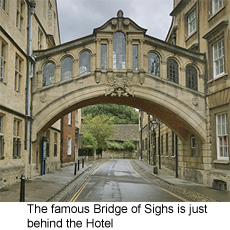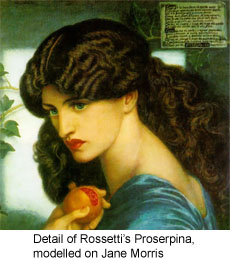Bath Place Hotel is a cluster of seventeenth-century cottages surrounding a tiny flagstone courtyard in the heart of Oxford. They were built in the early sixteen hundreds by Flemish weavers who were granted permission to build against the outside of the city wall. It is believed that there had previously been a communal well and bathhouse on the site, which has given the street its name.
 Going even further back in time, the area now known as Bath Place was part of the medieval defences, being at the foot of the city wall, of which very little now remains. However, parts of it are exposed in the dining room of the hotel, and one can see a well-preserved section of it from several of the hotel windows.
Going even further back in time, the area now known as Bath Place was part of the medieval defences, being at the foot of the city wall, of which very little now remains. However, parts of it are exposed in the dining room of the hotel, and one can see a well-preserved section of it from several of the hotel windows.
The cottages nestle between New College, one of the University’s oldest colleges, and Hertford College, established in the thirteenth century. The New College bell tower, which has been in continual use since the thirteenth century, is visible from some of the hotel’s rooms.
The Turf Tavern neighbours the hotel, and is reputedly the oldest inn in the city. Originally known as the Spotted Cow, it was renamed in the nineteenth century having become a venue for illicit gambling, which included bear baiting and cock fighting.
 Bath Place cottages were domestic dwellings until 1900. Their occupants were drawn from the lowest ranks of society. Nevertheless, they are important to Oxford’s cultural heritage. Jane Burden, the daughter of a humble stockman, was born in one of the cottages and whilst attending a theatre performance she was noticed by the artist Dante Gabrielle Rossetti who invited her to become his model. Later she was engaged to Rossetti’s friend the poet Edward Burn-Jones. Jane became the embodiment of female beauty of the Pre-Raphaelite movement, and went on to marry William Morris. Bath Place is also mentioned in Thomas Hardy’s novel Jude the Obscure.
Bath Place cottages were domestic dwellings until 1900. Their occupants were drawn from the lowest ranks of society. Nevertheless, they are important to Oxford’s cultural heritage. Jane Burden, the daughter of a humble stockman, was born in one of the cottages and whilst attending a theatre performance she was noticed by the artist Dante Gabrielle Rossetti who invited her to become his model. Later she was engaged to Rossetti’s friend the poet Edward Burn-Jones. Jane became the embodiment of female beauty of the Pre-Raphaelite movement, and went on to marry William Morris. Bath Place is also mentioned in Thomas Hardy’s novel Jude the Obscure.
In 1900, Merton College bought the cottages from the City of Oxford for use as student accommodation. The rooms were a sign of status and were passed from one privileged student to another. Ex-students now in their eighties and nineties still return to visit the hotel.
Edward VII often visited acquaintances lodging at Bath Place. Well-known mystery writer and translator of Dante, Dorothy L. Sayers, lived at Bath Place in the nineteen-tens and has written about her experiences here.
In the late sixties, Wally Eels, local character and landlord of the Turf Tavern, converted the cottages into a Bed and Breakfast which he ran successfully until the early eighties. Amongst the most famous of his guests were Richard Burton and Elizabeth Taylor who used Bath Place on more than one occasion as a secret rendezvous during Burton’s appearances at the Oxford Playhouse.
After Wally’s death the buildings stood empty and fell into disrepair until 1988 when the Fawsitt family took over the properties and totally restored them to create the existing hotel. The establishment is still owned and run by one of the family to this day, and its rich history and character continues to attract visitors from all over the world.
